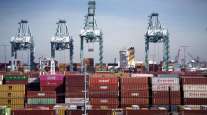Senior Reporter
West Coast Ports May Permanently Lose Volume Share to East Coast

[Stay on top of transportation news: Get TTNews in your inbox.]
For at least one month, August, the Port of New York and New Jersey was the busiest container port in the U.S. as it nudged ahead of longtime leader Port of Los Angeles in total 20-foot-equivalent units processed.
As for the big three container facilities, the Port of N.Y-N.J. processed 843,191 TEUs in August, setting a record for the month. The Port of Long Beach, Calif., moved 806,940 TEUs, edging out Los Angeles’ 805,314.
In a statement, the Port of N.Y.-N.J. said of its record month the facility “handled a double-digit increase of cargo volume compared to pre-pandemic August 2019. The seaport was the busiest in the nation in August and marked 25 straight months of monthly cargo growth. August 2022 cargo volume increased by 24.1% compared to August 2019.”
#ICYMI We had a great #PortIndustryDay last week. Watch Bethann Rooney, @PortNYNJ director, provide an update on the current state of our #port, our record #cargogrowth and the current issues affecting the #maritime industry. https://t.co/UlTFXBnMxh pic.twitter.com/ctsCpqa1Tj — Port of NY & NJ (@PortNYNJ) September 23, 2022
Cargo volumes have been shifting to the Atlantic Coast for several months as shippers hedge their bets against a potential labor dispute on the West Coast. Also, operational issues in Southern California persist, with rail on-time results in the mid-50% to mid-60% range, according to the Surface Transportation Board, while the railroads say they are working to improve those figures by at least 10%.
“It’s a continuation of this whole year, which has been mitigation of a West Coast, longshore disruption,” S&P Global Transportation Economist Paul Bingham said. “You’ve had shippers being cautious and the biggest port of the East Coast is New York-New Jersey, so they are the biggest beneficiary. But there have been records at other ports on the Atlantic Coast; Savannah and Charleston, and some of the other ports. But New York-New Jersey has been No. 1 on the East Coast forever.”

Seroka
Port of Los Angeles Executive Director Gene Seroka said his team continues to watch the labor negotiations closely,but he has said for years that East Coast ports are becoming more competitive. Now shippers are bringing some of their fall and winter season cargo into the country sooner to make sure its on store shelves in October, November and December.
“Additionally, inflationary concerns and elevated inventory levels have made some retailers and e-commerce sellers more cautious,” he said.
Moving shipments from West Coast ports to East Coast facilities can add more than a week to the journey as the container vessels must go through the expanded Panama Canal, which was upgraded and rebuilt in 2016 to be able to accommodate the largest containerships. Bingham said even with the additional cost and time associated with the trip, shippers believe, for now, it’s worth the effort.

Bingham
“You want your goods as soon as you can,” he said. “There has been this risk mitigation by incurring higher costs and potentially a longer time, but with the presumption of greater certainty of delivery and trying to get your deliveries as close to your target as possible, given all the risks involved. That’s the balancing act for any supply chain manager since the beginning of the COVID-19 pandemic.”
Bingham said he believes the increase in cargo to the East Coast may be a permanent change, especially as ports such as Savannah and others improve their infrastructure.
“Some of that volume that serves two-thirds of the population, east of the Mississippi River, probably doesn’t go back to the West Coast,” he said. “The long term is, the West Coast has probably lost some share.”
But port officials on the West Coast say they are doing what they can to improve efficiency and make more capacity available, especially by clearing out tens of thousands of empty containers that were being used to shore cargo for weeks and months and by cutting by 90% the number of ships in San Pedro Bay waiting for a berth into Los Angeles and Long Beach.
.@PortofLongBeach Executive Director @MarioCorderoLB joins @JillMalandrino on #TradeTalks ship backlogs, consumer spending and inflation, and how the Port of Long Beach has been mitigating supply chain challenges. https://t.co/QiwPJF3JBV — TradeTalks (@TradeTalks) September 21, 2022
“We’re making great strides in reducing the number of ships queuing to enter the San Pedro Bay ports complex and quickly moving imports and empty containers out of the terminals,” Port of Long Beach Executive Director Mario Cordero said.
The move to the East Coast ports is not only taking place at N.Y.-N.J., but several other facilities farther south.
Record August trade has the Port of Savannah moving cargo at a rate of 6 million TEUs per year. Business conducted through Georgia's ports supports more than 560,000 jobs across the state.https://t.co/vZJ2pDxz4X — Georgia Ports (@GaPorts) September 13, 2022
Georgia’s Port of Savannah set an all-time record in August, processing 575,513 containers compared with 485,595 in 2021.
Port officials there have targeted 2025 as the year the facility is capable of processing 9.5 million containers a year, or nearly 800,000 per month once its expansion projects, now under construction, begin to come online in next year.
The Port of Virginia in August recorded its second-busiest month, moving 340,926 TEUs, up 10.7% compared with 307,023 a year ago. August’s TEU total was just 685 units shy of the previous all-time monthly volume set in May.
Want more news? Listen to today's daily briefing below or go here for more info:




